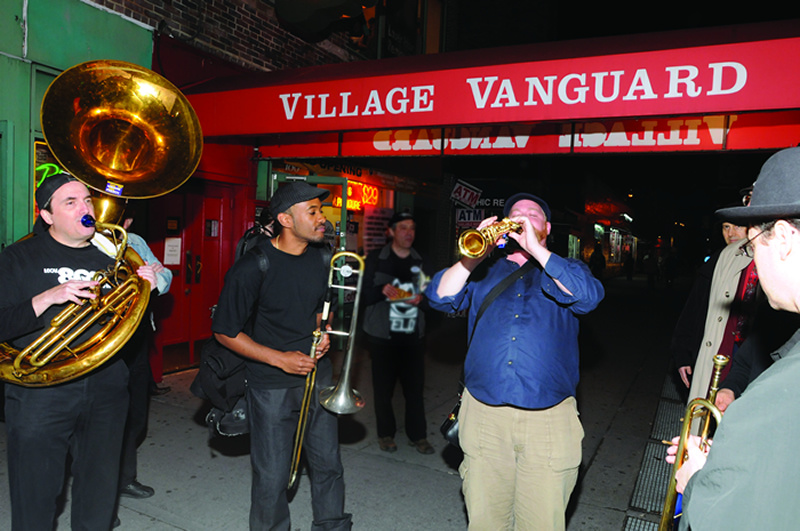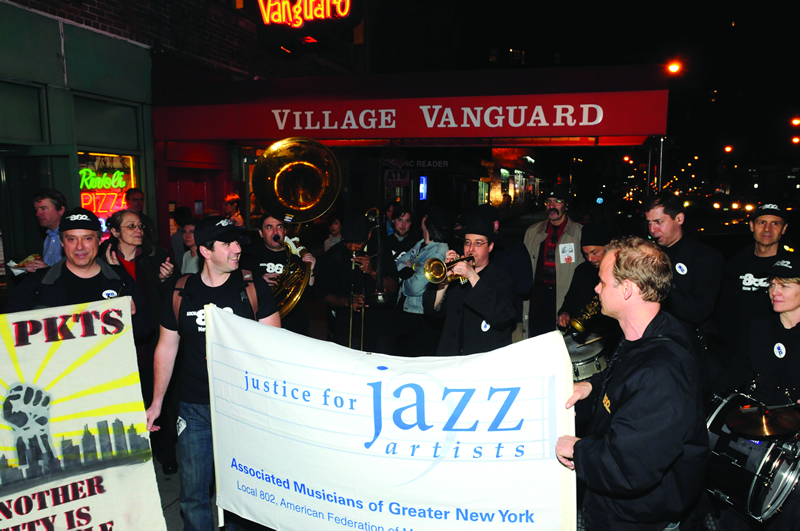Allegro
‘Five myths about the union’s jazz campaign’
Volume 112, No. 7/8July, 2012
  PLAYING FOR JUSTICE: Musicians and union supporters marched on the major jazz clubs on May 1 as part of t he union’s Justice for Jazz Artists campaign. |
As the Justice for Jazz Artists campaign continues apace with the effort to bring the major jazz clubs under collective bargaining agreements for pension benefits and other issues, we are seeing the support for this campaign grow among jazz artists, jazz musicians and jazz audiences.
Those supporters, as well as those of us involved in engineering and mapping out the campaign, often come up against prevalent themes of skepticism, embodied in certain misconceptions of what the campaign is meant to accomplish.
I’d like to take the time to address some of these points of skepticism by addressing five prevailing misconceptions we have heard from many different quarters.
Most of these myths have been perpetuated by the clubs in statements to the press and through secondhand sources.
But some of these have come from musicians as well, as legitimate concerns about the campaign.
MYTH #1: You’ll never get the clubs to do this.
For many years Local 802 has discussed the idea of winning pension contributions for musicians from the major jazz clubs, but had never developed a plan to do so.
That changed in 2006 with the idea of getting legislation passed that would eliminate the sales tax on admission charges at the night clubs and using the relief from sales tax to create a resource stream for pension contributions on behalf of musicians who played in the clubs.
This plan was seriously flawed in that there was no apparatus, once the tax relief was achieved, to make the contributions to the pension fund happen. The quid pro quo was all “quid” and no “quo.”
Clubs ended up getting the tax relief for their customers but there was nothing that compelled them to make the contributions to the pension fund
When the new Local 802 administration was elected in 2010, it realized two things: that the contributions to the pension fund would not happen without a collective bargaining agreement, and that the clubs would never enter into an agreement with Local 802 without an effective pressure campaign.
When we looked at collective bargaining as a goal, we recognized there were other issues that were important to musicians besides pension, namely recording protection, wages and redress of grievances.
These issues became part of our campaign and immediately created a basis by which we could garner more support among musicians.
Over the past several months we have increased our support among musicians tremendously, as well as among audience members who see our goals as just.
When we hear someone say, “the clubs will never agree to this,” our answer is that they will never agree to this unless we find the right leverage points.
Leverage points available to us include: undesirable publicity, embarrassment, political pressure, community pressure and finally the threat of economic pressure through loss of business from those who support our cause.
The fact is that in the last analysis, no night club wants to be considered a pariah in the jazz community.
A carefully thought-out campaign involving musicians, artists and audiences when targeted toward a specific club over an extended time will yield results.
We have seen this kind of campaign work within the labor movement and other social movement campaigns. It can work for the Justice for Jazz Artists campaign. We need only be focused and tenacious and we will win.
For years, the clubs refused to talk to us. Now that we have started leafleting and demonstrating in front of the clubs, we have gotten informal responses from each of the nightclubs’ staff and managers because our demonstrations have been effective.
It reminds me of what Gandhi once said, which I commented on in an earlier column: “First they ignore you. Then they laugh at you. Then they fight you. Then you win.”
Gandhi’s wisdom seems to be holding true in this case. They are no longer ignoring us.
MYTH #2: With live jazz struggling for audiences, this is not the time to go after the clubs.
One of our slogans in this campaign is “Now’s the Time.” Would we have been better served had we begun this ambitious campaign 10 or 20 years ago? Yes and no.
A successful campaign a decade or so ago would no doubt have been a good thing, but for numerous reasons, we weren’t ready for it. But that doesn’t mean we can’t be successful now and it doesn’t mean that jazz clubs can’t afford it.
Jazz audiences are in decline, but there are jazz clubs in this city that are making money hand over fist. If they weren’t, they wouldn’t be in business.
Our campaign is not about going after clubs whose business is precarious. We are seeking from the healthy clubs a benefit they can well afford. Our demands are not unreasonable and they will put no one out of business.
In fact, according to our analyses, pension contributions based on a fair minimum scale wage will have little effect on a major club’s bottom line.
Everyone knows it is more difficult than ever to make a living as a musician due to the decline of live music. Does that mean we should not fight for fairness for those who can manage to make it in this profession?
If we don’t organize in this field, it will continue to be a race to the bottom for pay to musicians, and it will be harder to make a living. We think it’s more important than ever to organize now.
MYTH #3: No one is going to get vested in the AFM pension fund by playing in the clubs.
A common misconception of our jazz campaign is that the final goal is to get the six major jazz clubs in New York to pay into the pension fund on behalf of jazz musicians. But that isn’t the goal.
The goal is to change the national landscape for single engagements in night clubs and other venues so that much of the field becomes covered by agreements that provide pension.
A national circuit of single engagements that pays pension will go a long way toward getting countless musicians vested in the pension fund.
AFM Local 47 (Los Angeles) has just joined our campaign and is opening a front on the West Coast. Soon other locals will join us as well.
But even with just a few major clubs in New York, it is quite possible for a musician to become vested in the pension fund by playing a few weekly runs over a period of successive years.
At a modest scale wage of say, $200 per show, a side musician would only have to play 15 nights per year five years running to become vested.
Many musicians play for different leaders and artists. Those musicians working these sorts of engagements on a regular basis would become vested in short order, if they are not vested already.
MYTH #4: This will be a bureaucratic nightmare for the clubs.
The New York Times reported that some nightclubs have said that making pension contributions for musicians would be “an accounting nightmare.”
But not one nightclub has inquired as to how contributions would be made, which would be a task so simple, a grade school student could do it.
Paying pension under a collective bargaining agreement would require one check sent once a month attached to a spreadsheet listing musicians’ social security numbers. Nothing could be simpler. We have scores of employers who do this all the time.
MYTH #5: The best way to do this is to make the bandleaders responsible for pension payments.
There are many reasons we are targeting the nightclubs – and not the bandleaders – as the responsible parties for pension payments, not the least of which adheres to the old notion of “following the money” if you want to get results.
The best way to assure pension contributions for everybody is to arrange for them at the source of the revenue stream and that is where the customers lay their money down to listen to jazz.
Another thing to consider is that to go after the leaders for pension contributions would be a logistical impossibility.
Enforcing a contract with hundreds of leaders is not realistic, when keeping track of a few clubs is relatively simple.
Enforcement is another consideration. Enforcing an agreement with countless leaders and artists does not make sense. A contract with the clubs will be eminently workable. Any adherence needed from leaders can be achieved through contractual arrangements with the clubs.
Since this union began discussing getting pension contributions from the clubs, the question of who is the employer of musicians in nightclubs has, in many ways, been a moot topic.
The fact is that there are numerous ways of entering into an agreement with club owners that puts this question to the side for our purposes.
The matter of who should be responsible for statutory benefits to musicians will not be settled by our achieving collective bargaining with the clubs.
This is a matter that is best left to the state of New York. Our agreement with the clubs will have little bearing there.
MOVING FORWARD
The Justice For Jazz Artists campaign has been alive for 15 years. We believe that through our recent efforts it has gotten considerable traction.
This won’t be an easy campaign and it won’t be a short one. But we are in it for the long haul and we expect to have some real results over the next several months.
Everyone in this union has a stake in this campaign, whether they play jazz or not. Our union needs to find ways to spread into fields where it has previously not had a great track record of delivering results.
Justice for Jazz Artists is essential to those efforts and it will provide a model for other such campaigns.
Together we will get this done. And when we do, we will be a much better union as a result.
